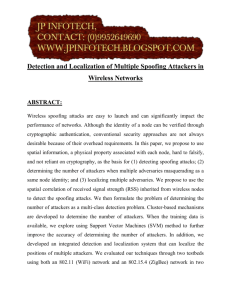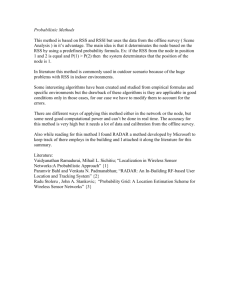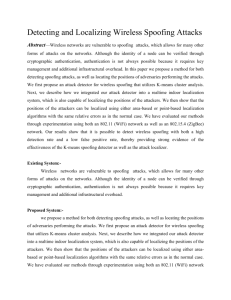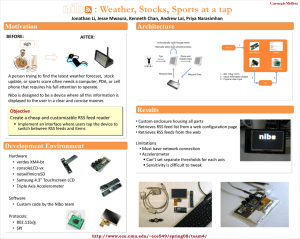Detection and Localization of Multiple Spoofers in Wireless Networks R. Ramakrishnan
advertisement
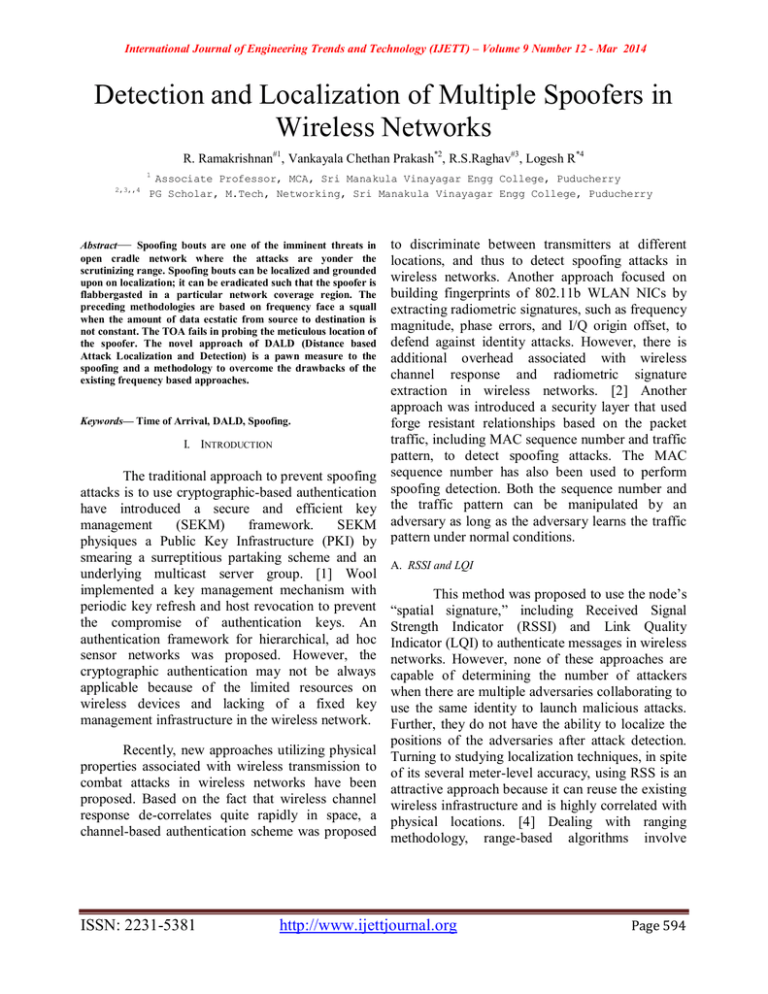
International Journal of Engineering Trends and Technology (IJETT) – Volume 9 Number 12 - Mar 2014 Detection and Localization of Multiple Spoofers in Wireless Networks R. Ramakrishnan#1, Vankayala Chethan Prakash*2, R.S.Raghav#3, Logesh R*4 1 2,3,,4 Associate Professor, MCA, Sri Manakula Vinayagar Engg College, Puducherry PG Scholar, M.Tech, Networking, Sri Manakula Vinayagar Engg College, Puducherry Abstract— Spoofing bouts are one of the imminent threats in open cradle network where the attacks are yonder the scrutinizing range. Spoofing bouts can be localized and grounded upon on localization; it can be eradicated such that the spoofer is flabbergasted in a particular network coverage region. The preceding methodologies are based on frequency face a squall when the amount of data ecstatic from source to destination is not constant. The TOA fails in probing the meticulous location of the spoofer. The novel approach of DALD (Distance based Attack Localization and Detection) is a pawn measure to the spoofing and a methodology to overcome the drawbacks of the existing frequency based approaches. Keywords— Time of Arrival, DALD, Spoofing. I. INTRODUCTION The traditional approach to prevent spoofing attacks is to use cryptographic-based authentication have introduced a secure and efficient key management (SEKM) framework. SEKM physiques a Public Key Infrastructure (PKI) by smearing a surreptitious partaking scheme and an underlying multicast server group. [1] Wool implemented a key management mechanism with periodic key refresh and host revocation to prevent the compromise of authentication keys. An authentication framework for hierarchical, ad hoc sensor networks was proposed. However, the cryptographic authentication may not be always applicable because of the limited resources on wireless devices and lacking of a fixed key management infrastructure in the wireless network. Recently, new approaches utilizing physical properties associated with wireless transmission to combat attacks in wireless networks have been proposed. Based on the fact that wireless channel response de-correlates quite rapidly in space, a channel-based authentication scheme was proposed ISSN: 2231-5381 to discriminate between transmitters at different locations, and thus to detect spoofing attacks in wireless networks. Another approach focused on building fingerprints of 802.11b WLAN NICs by extracting radiometric signatures, such as frequency magnitude, phase errors, and I/Q origin offset, to defend against identity attacks. However, there is additional overhead associated with wireless channel response and radiometric signature extraction in wireless networks. [2] Another approach was introduced a security layer that used forge resistant relationships based on the packet traffic, including MAC sequence number and traffic pattern, to detect spoofing attacks. The MAC sequence number has also been used to perform spoofing detection. Both the sequence number and the traffic pattern can be manipulated by an adversary as long as the adversary learns the traffic pattern under normal conditions. A. RSSI and LQI This method was proposed to use the node’s “spatial signature,” including Received Signal Strength Indicator (RSSI) and Link Quality Indicator (LQI) to authenticate messages in wireless networks. However, none of these approaches are capable of determining the number of attackers when there are multiple adversaries collaborating to use the same identity to launch malicious attacks. Further, they do not have the ability to localize the positions of the adversaries after attack detection. Turning to studying localization techniques, in spite of its several meter-level accuracy, using RSS is an attractive approach because it can reuse the existing wireless infrastructure and is highly correlated with physical locations. [4] Dealing with ranging methodology, range-based algorithms involve http://www.ijettjournal.org Page 594 International Journal of Engineering Trends and Technology (IJETT) – Volume 9 Number 12 - Mar 2014 distance estimation to landmarks using the measurement of various physical properties such as RSS, Time Of Arrival (TOA), Time Difference Of Arrival (TDOA), and direction of arrival (DoA). Whereas range-free algorithms use coarser metrics to place bounds on candidate positions. Another method of classification describes the strategy used to map a node to a location. [5] Lateration approaches use distances to landmarks, while angulation uses the angles from landmarks. Scene matching strategies use a function that maps observed radio properties to locations on a preconstructed signal map or database. Further, Chen et al. proposed to perform detection of attacks on wireless localization and Yang et al. proposed to use the direction of arrival and received signal strength of the signals to localize adversary’s sensor nodes. In this work, we choose a group of algorithms employing RSS to perform the task of localizing multiple attackers and evaluate their performance in terms of localization accuracy. B. Attack Detection Using Cluster Analysis The above analysis provides the theoretical support of using the RSS-based spatial correlation inherited from wireless nodes to perform spoofing attack detection. It also showed that the RSS readings from a wireless node may fluctuate and should cluster together. In particular, the RSS readings over time from the same physical location will belong to the same cluster points in the ndimensional signal space, while the RSS readings from different locations over time should form different clusters in signal space. We illustrated this important observation, which presents RSS reading vectors of three landmarks (i.e., n ¼ 3) from two different physical locations. Under the spoofing attack, the victim and the attacker are using the same ID to transmit data packets, and the RSS readings of that ID is the mixture readings measured from each individual node (i.e., spoofing node or victim node). Since under a spoofing attack, the RSS readings from the victim node and the spoofing attackers are mixed together, this observation suggests that we may conduct cluster analysis on top of RSS-based spatial correlation to ISSN: 2231-5381 find out the distance in signal space and further detect the presence of spoofing attackers in physical space. We utilize the Partitioning Around Medoids Method to perform clustering analysis in RSS. [10] The PAM Method is a popular iterative descent clustering algorithm. Compared to the popular Kmeans method, the PAM method is more robust in the presence of noise and outliers. Thus, the PAM method is more suitable in determining clusters from RSS streams, which can be unreliable and fluctuating over time due to random noise and environmental bias. C. Support Vector Machines-Based Mechanism Provided the training data collected during the offline training phase, we can further improve the performance of determining the number of spoofing attackers. In addition, given several statistic methods available to detect the number of attackers, such as System Evolution and SILENCE, [7] we can combine the characteristics of these methods to achieve a higher detection rate. In this section, we explore using Support Vector Machines to classify the number of the spoofing attackers. The advantage of using SVM is that it can combine the intermediate results (i.e., features) from different statistic methods to build a model based on training data to accurately predict the number of attackers. D. The SILENCE Mechanism The advantage of Silhouette Plot is that it is suitable for estimating the best partition. [6] Whereas the System Evolution method performs well under difficult cases such as when there exists slightly overlapping between clusters and there are smaller clusters near larger clusters. However, we observed that for both Silhouette Plot and System Evolution methods, the Hit Rate decreases as the number of attackers increases, although the Precision increases. This is because the clustering algorithms cannot tell the difference between real RSS clusters formed by attackers at different positions and fake RSS clusters caused by outliers and variations of the signal strength. http://www.ijettjournal.org Page 595 International Journal of Engineering Trends and Technology (IJETT) – Volume 9 Number 12 - Mar 2014 II.EXISTING SYSTEM A. RSS based Attack Detection The challenge in spoofing detection is to devise strategies that use the uniqueness of spatial information, but not using location directly as the attackers’ positions are unknown. [4] We propose to study RSS; a property closely correlated with location in physical space and is readily available in the existing wireless networks. Although affected by random noise, environmental bias, and multipath effects, the RSS measured at a set of landmarks (i.e., reference points with known locations) is closely related to the transmitter’s physical location and is governed by the distance to the landmarks. The RSS readings at the same physical location are similar, whereas the RSS readings at different locations in physical space are distinctive. Thus, the RSS readings present strong spatial correlation characteristics. two distinct RSS clusters in signal space (i.e., Dm will be large). We varied transmission power for an attacker from 30 mW (15 dBm) to 1 mW (0 dBm). We found that in all cases Dm is larger than normal conditions. [9] When the spoofing attacker used transmission power of 10 dB to send packets, whereas the original node used 15 dB transmission power levels. We observed that the curve of Dm under the different transmission power level shifts to the right indicating larger Dm values. Thus, spoofing attacks launched by using different transmission power levels will be detected effectively in GADE. C. Attacker Number Determination The System Evolution is a new method to analyze cluster structures and estimate the number of clusters. [14] The System Evolution method uses the twin-cluster model, which are the two closest clusters (e.g., clusters a and b) among K potential clusters of a data set. The twin-cluster model is The detection power of the existing used for energy calculation. approach is by using the RSS-based spatial correlation. There are four landmarks deployed at the four corners of the square area. The physical D. IDOL: Integrated Detection And Localization Framework distance between two wireless devices is 16, 20, The traditional localization approaches are and 25 feet, respectively. The path loss exponent _ based on averaged RSS from each node identity is set to 2.5 and the standard deviation of inputs to estimate the position of a node. However, shadowing is 2 dB. The ROC curves shift to the in wireless spoofing attacks, [6] the RSS stream of upper left when increasing the distance between a node identity may be mixed with RSS readings of two devices. [11] This indicates that the farther both the original node as well as spoofing nodes away the two nodes are separated, the better from different physical locations. The traditional detection performance that our method can achieve. method of averaging RSS readings cannot This is because the detection performance is differentiate RSS readings from different locations proportional to the no centrality parameter, which is and thus is not feasible for localizing adversaries. represented by the distance between two wireless nodes together with the landmarks. A larger Different from traditional localization standard deviation of shadowing causes the two approaches, our integrated detection and distributions, i.e., no central chi-square and central localization system utilize the RSS medoids chi-square, to get closer to one another. returned from SILENCE as inputs to localization algorithms to estimate the positions of adversaries. The return positions from our system include the B. Handling Different Transmission Power Levels location estimate of the original node and the If a spoofing attacker sends packets at a attackers in the physical space. Handling different transmission power level from the original adversaries using different transmission power node, based on our cluster analysis there will be levels. An adversary may vary the transmission ISSN: 2231-5381 http://www.ijettjournal.org Page 596 International Journal of Engineering Trends and Technology (IJETT) – Volume 9 Number 12 - Mar 2014 power levels when performing spoofing attacks so A. DALD (Distance based Attack Localization and that the localization system cannot estimate its Detection) location accurately. The DALD approach is based on the distance of each data that travels from source to E. Algorithms destination. For one cycle of data transmission, the In order to evaluate the generality of IDOL distance is calculated based on the TOA and the for localizing adversaries, we have chosen a set of sender node’s position. The frequency parameter is representative localization algorithms ranging from excluded from the scenario. It means the node can nearest neighbour matching in signal space operate in any frequency or 2 or more nodes can (RADAR), to probability-based (Area-Based exist in a same frequency or in a same frequency Probability (ABP)), and to multi-lateration region. The difference is that each node has (Bayesian Networks (BN)), RADAR-gridded. The different physical locations despite they even share RADAR-Gridded algorithm is a scene-matching the common frequency or exist in the same localization algorithm extended from. [11] frequency region. RADAR-Gridded uses an interpolated signal map, which is built from a set of averaged RSS readings A. The DALD works as follows: with known locations. Given an observed RSS Compute the sender node’s location with reading with an unknown location, RADAR returns respect to the co-ordinates. the x, y of the nearest neighbour in the signal map to the one to localize, where “nearest” is defined as Compute the location of the receiver (Self the Euclidean distance of RSS points in an NKnown) dimensional signal space, where N is the number of landmarks. Calculate the distance between source and F. Area-based probability destination using the co-ordinate positions of both the source and destination. ABP also utilizes an interpolated signal map. Further, the experimental area is divided into a Store the difference in distance of the regular grid of equal-sized tiles. ABP assumes the request packet in a localization table. distribution of RSS for each landmark.[13] For every “i” in “n” cycle of data transfer, check if the data is arriving from the same II. PROPOSED SYSTEM destination (based on distance). We propose an algorithm based on the distance by using received signal strength the attackers can be found easily. The DALD Algorithm will provide the location of the attackers easily by the difference in distance or frequency since the packet flow from source will be at some frequency whereas the attacker will have some other frequency so the frequency mismatch will provide the difference between the source and the attacker ISSN: 2231-5381 If any of the data is occurring from a different localization value then drop the packet and terminate the connection. B. IDS An intrusion detection system (IDS) scrutinizes all inbound and outbound network bustle and ascertains chary patterns that may indicate a network or system attack from someone endeavouring to break into or conciliate a system.[3] There are numerous techniques to catalogue IDS: http://www.ijettjournal.org Page 597 International Journal of Engineering Trends and Technology (IJETT) – Volume 9 Number 12 - Mar 2014 Misuse detection vs. anomaly detection: in misuse detection, the IDS scrutinize the information it wrinkles and parallels it to hefty databases of spasm monikers. Basically, the IDS miens for a unambiguous attack that has previously been renowned. Like a virus detection system, misuse detection software is merely as virtuous as the database of attack signatures that it routines to match packets against. In anomaly detection, the system administrator delineates the baseline, or normal, state of the networks traffic load, breakdown, protocol, and typical packet size. The anomaly detector monitors network slices to associate their state to the customary baseline and guise for anomalies. IV. EXPERIMENTAL RESULTS Nodes changes their location often so stale routes are generated which leads to unnecessary routing overhead so packet filtering is used to control the flow of packets. If a packet is sent on a local segment of the devices if it is not acceptable by other devices then those packets are discarded. But our proposed algorithm provides the advancement of preventing the attackers and their location can be identified easily. Network-based vs. host-based systems: in a network-based system, or NIDS, the distinct packets flowing through a network are scrutinized. The NIDS can spot malevolent packets that are premeditated to be unheeded by firewalls simplistic filtering procedures. [8] In a host-based system, the IDS inspects at the bustle on each discrete computer or host. Fig 1 Results of DALD algorithm for routing overhead Passive system vs. reactive system: in a passive system, the IDS identify a potential security breach, log the information and gesture an alert. In a reactive system, the IDS retort to the apprehensive activity by logging off a user or by reprogramming the firewall to hunk network traffic from the alleged malevolent source. Due to RSS based detections, the routing faces deprecation at the intermediate nodes as each node operate at different frequencies. From Fig 1 DALD work upon the distance and then proceed with routing such the overhead is lessening by few percent. However they both transmit to network security, ID fluctuates from a firewall in that a firewall looks out for incursions in order to sojourn them from happening. The firewall restricts the access amongst networks in order to foil incursion and does not gesture an attack from privileged network. An IDS gauges a distrusted intrusion once it has taken place and gestures an alarm. An IDS also watches for bouts that instigates since within a system. Fig 2 Delay advancement using DALD Algorithm As the number of requests increases the servicing time for each request increases. Thereby the overall ISSN: 2231-5381 http://www.ijettjournal.org Page 598 International Journal of Engineering Trends and Technology (IJETT) – Volume 9 Number 12 - Mar 2014 delay increases. From Fig 2 the DALD method provides less delay when compared to RSS scheme where the delay is based on the receiving frequency and the data rate. [6] A. Wool, “Lightweight Key Management for IEEE 802.11 Wireless Lans With Key Refresh and Host Revocation,” ACM/Springer Wireless Networks, vol. 11, no. 6, pp. 677-686, 2005. V.CONCLUSION [7] Y. Sheng, K. Tan, G. Chen, D. Kotz, and A. Campbell, 泥etecting 802.11 MAC Layer Spoofing Attacker detection and localization using RSS faces storm when the attacker is operating at the same Using Received Signal Strength, ・ Proc. IEEE frequency as the host. It fails when the distance INFOCOM, Apr. 2008. between source and destination decreases. The location based attacker localization computes the [8] J. Yang, Y. Chen, and W. Trappe, “Detecting Attacks in Mobile Wireless exact position of the attacker with correspondence Spoofing Environments,” Proc. Ann. IEEE Comm. Soc. Conf. to the geological positions and thus measures the Sensor, Mesh and Ad Hoc Comm. and Networks physical distance based on the locations. Hence a client can inspect if a packet travels from the same (SECON), 2009. distance as the source in the following approaches. This reduces the possibility of attack and attack [9] Y. Chen, W. Trappe, and R.P. Martin, Detecting and Localizing Wireless Spoofing Attacks,・ Proc. detection. VI.REFERENCES Ann. IEEE Comm. Soc. Conf. Sensor, Mesh and Ad Hoc Comm. and Networks (SECON), May 2007. [1] J. Bellardo and S. Savage, ・802.11 Denial-ofService Attacks: Real Vulnerabilities and Practical Solutions,・ Proc. USENIX Security Symp., pp. 15- [10] M. Bohge and W. Trappe, “An Authentication 28, 2003. Framework for Hierarchical Ad Hoc Sensor Networks,” Proc. ACM Workshop Wireless [2] F. Ferreri, M. Bernaschi, and L. Valcamonici, Security (WiSe), pp. 79-87, 2003. “Access Points Vulnerabilities to Dos Attacks in 802.11 Networks,” Proc. IEEE Wireless Comm. [11] L. Xiao, L.J. Greenstein, N.B. Mandayam, and and Networking Conf., 2004. W. Trappe, Fingerprints in the Ether: Using the Physical Layer for Wireless Authentication,・ Proc. [3] D. Faria and D. Cheriton, 泥etecting Identity- IEEE Int値 Conf. Comm. (ICC), pp. 4646-4651, Based Attacks in Wireless Networks Using June 2007. Signalprints, ・ Proc. ACM Workshop Wireless Security (WiSe), Sept. 2006. [12] V. Brik, S. Banerjee, M. Gruteser, and S. Oh, “Wireless Device Identification with Radiometric [4] Q. Li and W. Trappe, “Relationship-Based Signatures,” Proc. 14th ACM Int’l Conf. Mobile Detection of Spoofing-Related Anomalous Traffic Computing and Networking, pp. 116-127, 2008. in Ad Hoc Networks,” Proc. Ann. IEEE Comm. Soc. on IEEE and Sensor and Ad Hoc Comm. and [13] F. Guo and T. Chiueh, 鉄equence NumberNetworks (SECON), 2006. Based MAC Address Spoof Detection, ・ Proc. Eighth Int Conf. Recent Advances in Intrusion [5] B. Wu, J. Wu, E. Fernandez, and S. Magliveras, Detection, pp. 309-329, 2006. 鉄ecure and Efficient Key Management in Mobile Ad Hoc Networks,・ Proc. IEEE Int値 Parallel and [14] L. Sang and A. Arora, 鉄patial Signatures for Distributed Processing Symp. (IPDPS), 2005. Lightweight Security ISSN: 2231-5381 http://www.ijettjournal.org Page 599
